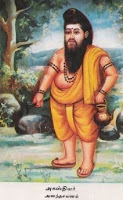When we look at scientists who are credited with the most important ideas of our time we find mainly Greeks, Europeans, Americans listed. Yet western history seems to have been arbitrarily begun during the Greek era. In fact, when we extend the boundaries of history to view the longer span of history we find some amazing developments predating "modern" history originating in India more than 5,000 years ago.
The ancient thinkers of India were not only scientists and mathematicians, but also deeply religious, esteemed saints of their time. While it may surprise some to think of religious sages as mundane scientists, the Indian view is that religion (universal) and science are but two sides of the same coin - in short¡Ksemantics. Whether one calls a natural phenomena wind or the wind god - Vayu - one is speaking of the same thing.
Yet it seems that having a spiritual foundation not only brought out important discoveries still in use today, but these discoveries also were helpful without causing harm or destruction.
In fact this article will cite the origins of some amazing and here-to-for mis-credited discoveries as coming from India. Some examples include so-called Arabic numerals, the concept of the zero, so-called Pythagorean theory, surgery and more. It may seem astonishing, but the ancient texts are there to show the thinking and writing of these great Indian thinkers.
Why is India not credited? It seems that in the West we have a condescending, Euro- or Greco-centric view that civilizations older than Greece were uncivilized barbarians. This notion was further melded into our collective psyche through Hollywood's portrayal of ancient cultures. One only has to look at old Tarzan movies to see ancient tribes shown as barbaric, superstitious idol worshipping people. Tarzan himself was shown to be a non-speaking animal-like person. In fact, in the original books, Tarzan was a well-educated and highly eloquent speaker.
Chauvinistic misrepresentation exists even today. Nearly every book written on the history of mathematics is equally biased. The one bright spot is the Crest of the Peacock. Even this year, during the recent Hindu festival, the Kumbha Mela - the largest human gathering in history (70 million people) the modern-day press mainly reported on the most negative aspects of the event.
It was not credited as the largest gathering, nor was it pointed out that for 1 week, the area was the worlds largest city (larger population than London, Tehran, Rio, Paris, Chicago, Beijing, Hyderabad and Johannesburg put together). Virtually no one spoke of the sacredness of the event, the hardships people endured for this holy event. Further, the whole event went off without a hitch - adequate food, water, electricity - a marvel by any standards. There were more than 13,000 tons of flour, 7,800 tons of rice, 20,000 public toilets, 12 hospitals, 35 electric power centers, 20,000 police, 1,090 fire hydrants and much more.
Rarely was an ardent devotee interviewed or photographed. Instead reporters and cameramen only focused on the minority elements - naked sadhus smoking ganja (marijuana) and implying prayers were to some lesser god. But it sells newspapers and TV news. In truth, the Indian media showed an equal amount of bias and lack of cultural pride. In short the media still portrays India in a deeply condescending manner.
But I digress. The point is that westerners have been brought up for decades incorrectly viewing ancient civilizations as intellectually and culturally inferior to modern man. So it is no surprise to be surprised in learning some of the greatest discoveries not only came from India, but from ancient India. It shakes the very foundations of prejudicial beliefs. Here are but a few examples of India's enlightened thinkers.
Amazing Science
(Saints and Science)
By Swami Sada Shiva Tirtha





.jpg) Kundalini and the Brain
Kundalini and the Brain 



